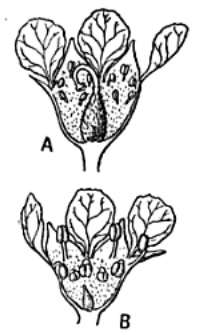Prunus minutiflora
| Prunus minutiflora | |
|---|---|
 | |
| Prunus minutiflora flowers: A-Pistil (female), B-Stamen (male) | |
| Scientific classification | |
| Kingdom: | Plantae |
| (unranked): | Angiosperms |
| (unranked): | Eudicots |
| (unranked): | Rosids |
| Order: | Rosales |
| Family: | Rosaceae |
| Genus: | Prunus |
| Subgenus: | Amygdalus |
| Species: | P. minutiflora[1] |
| Binomial name | |
| Prunus minutiflora Engelm. ex A. Gray 1850 not S.Watson 1871 | |
| Synonyms[2][3] | |
| |
Prunus minutiflora, called the Texas almond,[4] is a shrub native to Texas and northern Mexico.[1]
'Minutiflora' means "minute flower" as the flowers of this shrub are very tiny, with petals being only 0.079 in (2.0 mm) long.[5] It has small flowers and dark brown/black to pinkish-red fruits that are only about 0.5 in (1.3 cm) in diameter. The shrubs grow up to 3 ft (0.91 m) tall in thickets.[6] It is dioecious, having male and female flowers on separate plants,[7] which is rare for Prunus.[8] It mainly grows in limestone soils.[9]
References
- 1 2 GRIN (October 12, 2011). "Prunus minutiflora Engelm.". Taxonomy for Plants. National Germplasm Resources Laboratory, Beltsville, Maryland: USDA, ARS, National Genetic Resources Program. Retrieved December 30, 2014.
- ↑ The Plant List, Prunus minutiflora Engelm. ex A.Gray
- ↑ Tropicos, Prunus minutiflora Engelm. ex A. Gray
- ↑ "Prunus minutiflora". Natural Resources Conservation Service PLANTS Database. USDA. Retrieved 14 October 2015.
- ↑ Mason, Silas C. (1914). "The Pubescent-Fruited Species of Prunus of the Southwestern States". Journal of Agricultural Research. Washington, DC: United States Department of Agriculture. 1 (2): 172–174.
- ↑ "Prunus minutiflora". Lady Bird Johnson Wildflower Center. Retrieved December 30, 2014.
- ↑ "Texas Almond, Peachbrush, Small-flower Peach-brush". Texas A&M University. Retrieved December 30, 2014.
- ↑ Okie, W. R. (2006). "Introgression of Prunus Species in Plum" (PDF). New York Fruit Quarterly. 14 (1): 29–37.
- ↑ Powell, A. Michael (1998). Trees & Shrubs of the Trans-Pecos and Adjacent Areas. Austin: University of Texas Press. p. 151. ISBN 0-292-76579-7.
External links
| Wikimedia Commons has media related to Prunus minutiflora. |
| Wikispecies has information related to: Prunus minutiflora |
This article is issued from
Wikipedia.
The text is licensed under Creative Commons - Attribution - Sharealike.
Additional terms may apply for the media files.